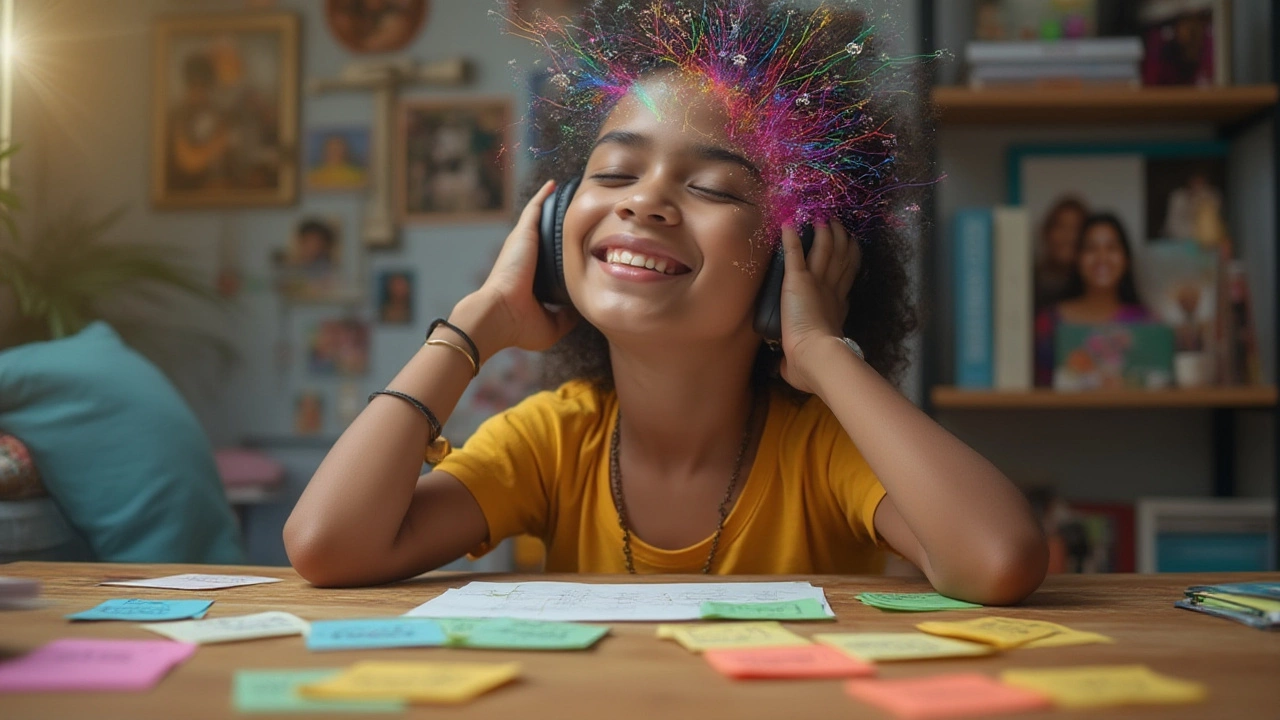Ever wondered why a toddler can soak up a new language without blinking, but as an adult, memorizing basic phrases somehow feels like climbing Mount Everest wearing flip flops? Here’s the kicker: Your adult brain wasn’t meant to get stuck in a rut. Quietly, right inside your head, your brain is buzzing with whether you realize it or not—a superpower called neuroplasticity. That’s science-shorthand for your brain’s ability to change, adapt, and build brand new connections even as you read this sentence. So, yes, you absolutely can ‘rewire’ your own mind to learn a new language. But you need to know which wires to tug on, which circuits need a jumpstart, and—most importantly—how to keep your motivation switched on after the buzz of your first Duolingo streak fades away.
The Brain Science Behind Language Learning
The magic all starts in that crumpled, walnut-shaped thing you carry around on your shoulders. When scientists looked at MRI scans of bilinguals, they saw a thickening in areas like the left inferior parietal cortex. That’s the bit of gray matter that helps you process language and manage your vocabulary. What’s even cooler: Studies show even adults can grow this area with dedicated practice. Stanford’s Language Learning Lab reported measurable density increases after just a few months of daily learning.
Most people think brains are pretty much fixed after childhood. Turns out, they’re dead wrong. Neuroplasticity, the techy term for “brain rewiring,” never really shuts down. Harvard neuroscientists found that adults who actively train a new skill, like language, sprout new neural connections (called dendritic branches) well into their sixties and seventies. You aren't stuck with your current mental wiring—you can upgrade, big time, if you know how.
How does this actually work with language? Every time you memorize a new word or repeat a sentence, your brain lays a weak electrical pathway between neurons. The more you practice, the more myelin—the brain’s insulation—wraps around that pathway. It’s like smoothing over a forest trail every time you walk it: the clearer the path, the faster your brain can fire a word from memory. Want to shortcut this? Mix repetition (flashcards, listening, reading) with variety (stories, conversations, shadowing exercises). That’s how polyglots, people who speak five or more languages, train their gray matter to pivot easily between French, Italian, or Japanese.
Here’s a fact to chew on: babies don’t actually have a language “learning gene”—they just get more constant, immersive exposure. The more senses you bring to the party, the deeper those words stick. Smell your morning coffee while whispering ‘café’; trace the letters of a tricky Russian word on your hand; sing children’s songs out loud, however silly you feel.
Don’t ignore the power of mistakes. Every time you flub a sentence, your brain gets a little buzz from a chemical called dopamine, nudging it to take notice and do better next time. The trick? Keep failing forward. The science says that the most progress comes right at that edge where things are just challenging enough to spark growth—what educational psychology calls “desirable difficulty.”
Professor Angela Friederici, director at the Max Planck Institute for Human Cognitive and Brain Sciences, said it bluntly:
“Our brains remain plastic. Even in adulthood, intensive language training stimulates new connections, expanding the brain’s capacity for communication.”So all that practice isn’t just a chore; it’s literally reforming who you are—at least, inside your head.

Everyday Actions That Build New Neural Pathways
Knowing your brain can rewire itself is one thing. Doing it deliberately, every day, is another story. Start by ditching perfectionism. Waiting to feel ‘ready’ or trying to memorize a whole textbook will strangle your progress before it starts. Instead, aim for what scientists call ‘micro-learning’—breaking things into small, frequent sessions. Even ten minutes twice a day works better than one exhausting weekend cram. The British Journal of Educational Psychology reported learners who practiced for short, focused bursts managed to retain information twice as long as marathon studiers.
Habit stacking works wonders. Pair your language reps with something you already do daily, like brushing your teeth or making breakfast. You might learn one Spanish phrase while making coffee, another during your post-lunch walk. Effortless, predictable, and way harder to flake out on.
Don’t camp out in your comfort zone. Your brain gets lazier every time you mindlessly scroll through basic vocab lists or listen to podcasts you already understand. Push yourself to try new materials, even if half the words sound like gibberish right now. Struggle means growth. The Polyglot Conference crowd—folks who’ve made language learning a lifestyle—swears by the “comprehensible input” theory: exposing yourself to material that’s just a little out of reach forces your brain to fill in the blanks, stretching your wiring.
Here are some brain-savvy tricks to accelerate change:
- Mix your practice routines. Read a comic, listen to recipes, record yourself repeating sentences. Variety keeps your neurons awake and growing.
- Use ‘spaced repetition.’ Tools like Anki or Memrise serve you flashcards just before you forget them, perfect for locking in tricky vocab.
- Engage with real people—messaging apps, voice chats, gaming communities, or local meetups. Real conversations lay down the deepest pathways since there’s pressure, unpredictability, and reward all at once.
- Write it out. Journaling or texting in your new language mixes memory, movement, and creativity—way stronger than silent reading alone.
- Get physical. Use hand gestures, facial expressions, or even act scenes out. Science says linking movement and speech fires up extra brain regions, embedding those words more deeply.
Don’t ignore your emotions. Motivation isn’t some random spark—it’s driven by dopamine and adrenaline. Track tiny wins, like finishing a short story or holding a two-minute conversation. Reward yourself. And yes, there’s evidence that sharing your progress online or with friends supercharges perseverance—when someone else knows you’re trying, you’re way less likely to bail.
If you hit a wall—and you will—shift your routine. Turn passive listening into active production: narrate your evening aloud in your new language or translate social media posts in real time. Changing gears keeps your brain guessing and triggers new wiring each time.
Sleep on it, too. While you snooze, your brain sorts and stores the day’s language learning into longer-term memory. It’s not a myth—University of York studies found learners who napped after practice performed better on recall tests than those who stayed awake. So next time you feel guilty for skipping a late-night cram, remember: a good nap works wonders.

Making Language Learning Stick: Mindsets and Habits
Once you know how your brain works, the real challenge is turning those clever hacks into a way of life. First, reframe the whole idea of ‘talent.’ Most research points to consistent, high-quality exposure—not a gift you’re born with—as the biggest driver. Dr. Barbara Oakley, author of “Learning How to Learn,” writes,
“Persistence trumps brilliance. It’s the slow grooves made by daily practice that carve the deepest neural ruts.”Remember, nobody speaks fluently overnight, and those viral ‘polyglot in 3 weeks’ videos? Usually smoke and mirrors, or at best, a lot of prior hard work edited down for clicks.
Set goals you can actually reach. Instead of “Be fluent in Italian by Christmas,” try “Order food and ask directions with confidence” or “Watch a TV episode without subtitles.” Celebrate every milestone, no matter how tiny. According to a 2023 MIT study, positive reinforcement fuels the formation of new synapses, making learning addictive in the best possible way.
Stick with what gets results. If you hate grammar drills but love chatting, focus on conversation first. If you’re a visual learner, color-code your vocab or put sticky notes all over your house. Honestly, whatever you enjoy most is what you’ll actually keep doing—your brain learns best when you’re relaxed and engaged, not dreading another “fill in the blank” worksheet.
Here’s where mindset collides with biology. Fear of making mistakes—especially in adults—can actually shut down parts of the brain critical for language processing. So, give yourself permission to sound silly or stumble. Laugh off awkward moments; every embarrassing mispronunciation is another brick in your language-learning fortress. The more playful your approach, the faster your brain will adapt.
Try building community. Research out of the University of Edinburgh tracked students in tandem language programs (where two learners swap their native languages), and found both groups advanced roughly 40% faster than those studying alone. When you have someone rooting for you, you absorb vocabulary and nuance almost by osmosis.
Don’t forget the power of curiosity. Let your interests steer your learning. Love cooking? Follow recipes or watch food vlogs in your new language. Into music? Translate your favorite song lyrics. This simple trick pulls you along by natural enjoyment, rather than sheer discipline.
Your brain’s potential is wild. The right habits, a dose of patience, and a genuine sense of curiosity can push you past any mental block you’ve ever hit. Fluency isn’t just about crossing a finish line—it’s a long road built from daily neural upgrades. So, if you’re serious about rewiring your brain for a new language, look at your routines, shake up your practice, and remember: your brain is a living, changeable thing. With each new phrase you learn today, you’re literally not the same person as you were yesterday.





